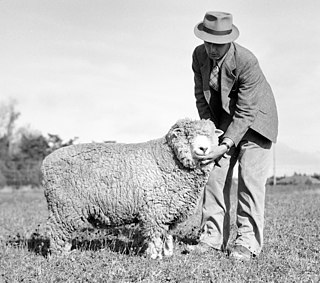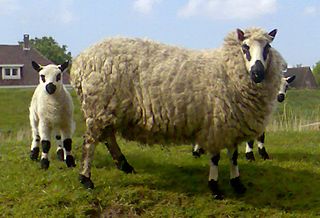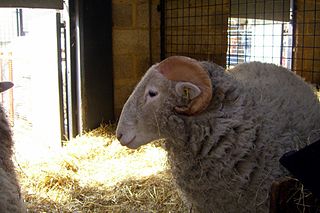The Perendale is a breed of sheep developed in New Zealand by Massey Agricultural College for use in steep hill situations. The breed is named after Sir Geoffrey Peren, and it achieves its aims by being the offspring of Romney ewes and Cheviot rams with sturdy legs. It is raised primarily for meat.
Polwarth is a breed of sheep that was developed in Victoria (Australia) during 1880. They were of one-quarter Lincoln and three-quarters Merino bloodlines. They are large, predominantly polled sheep with long, soft, quite fine wool and produce good meat carcasses. They were developed in an attempt to extend the grazing territory of sheep because the Merino was found lacking in hardiness in this respect. A dual-purpose breed with a major emphasis on wool production. Richard Dennis, of Tarndwarncoort in south west Victoria, bred the Polwarth, first known as Dennis Comebacks. Descendants of Richards Dennis continue to grow Polwarth wool at Tarndwarncoort, maintaining the original bloodlines in a flock referred to as the "Blue Dots".

The Lincoln, sometimes called the Lincoln Longwool, is a breed of sheep from England. The Lincoln is the largest British sheep, developed specifically to produce the heaviest, longest and most lustrous fleece of any breed in the world. Great numbers were exported to many countries to improve the size and wool quality of their native breeds. The versatile fleece is in great demand for spinning, weaving and many other crafts.

The Oxford Down is an English breed of domestic sheep developed in the 1830s by crossing the Cotswold, Hampshire and South Down breeds, and using the resulting cross-breeds to form the basis of the present-day breed. This breed is primarily raised for meat.

Not to be confused with the Olde English 'Babydoll' Southdown sheep.

The Targhee is a breed of domestic sheep developed in early 20th century by the USDA's Agricultural Research Service. Targhee sheep are a dual-purpose breed, with heavy, medium quality wool and good meat production characteristics. They are hardy, and are especially suited to the ranges of the West where they were developed. Targhee are especially popular in Montana, Wyoming and South Dakota, where their ¾ fine wool and ¼ long wool breeding is favored by western ranchers. This breed is raised primarily for wool.

Corriedale sheep are a dual purpose breed, meaning they are used both in the production of wool and meat. The Corriedale is the oldest of all the crossbred breeds, a Merino-Lincoln cross developed almost simultaneously in Australia and New Zealand and first brought to the United States in 1914. The Corriedale is internationally farmed, in Australia, New Zealand, the United States of America, Southern Brazil, Uruguay and Patagonia. Corriedales are one of the most popular sheep breeds in Uruguay. On the Falkland Islands, Polwarth and Corriedale form the main sheep breeds.

The Bluefaced Leicester (BFL) is a longwool breed of sheep which evolved from a breeding scheme of Robert Bakewell, in Dishley, Leicestershire in the eighteenth century. First known as the Dishley Leicester, and then the Hexham Leicester, because of the prevalence of the breed in Northumberland, the name Bluefaced Leicester became known at the beginning of the 20th century. In the 1970s, the Bluefaced Leicester was exported to Canada. Exported frozen semen from the United Kingdom is now used to expand the genetic diversity in Canada and the United States. This breed is raised primarily for meat, but their fleece is becoming increasingly popular for handspinning. Bluefaced Leicester sheep may also have brown on their face. The sell record has been set by a brown ram lamb selling for 23,000 guineas.

Welsh Mountain sheep are small, hardy sheep from the higher parts of the Welsh mountains. The males have horns, and the females are polled (hornless); they have no wool on the face or legs, and they have long tails. There are a number of varieties, bred for sheep farming in Wales. These are mainly colour variations, but some are being developed as separate breeds.

The Columbia is one of the first breeds of sheep developed in the United States. The product of USDA and university research, it was intended to be an improved breed adapted for the Western ranges of the country.
The Debouillet is a breed of domestic sheep originating from Tatum, New Mexico. It was developed in the 1920s through crossing Rambouillet and Delaine Merino sheep and the breed's name is a portmanteau of these two ancestors. This breed is primarily raised for its wool.

The Kerry Hill is a breed of domestic sheep originating in the county of Powys in Wales. It derives its name from the village of Kerry (Ceri), near Newtown. Kerry Hill sheep have a distinctive and unique coloration, with a white face bearing black markings around the mouth, ears, and eyes. Both rams and ewes are polled. Their wool is white, and their legs are white with black markings. First mentions of the breed date back to the early 19th century, and today it is distributed throughout the United Kingdom, Ireland, the Netherlands, Germany and Denmark. Though still not very numerous, the breed was removed from the records of the Rare Breeds Survival Trust watchlist in 2006. This breed is primarily raised for meat.

The Whitefaced Woodland is a sheep breed from the Woodlands of Hope an area in the South Pennines in England. It is a combination of two breeds, the Woodland and the Penistone sheep after the Yorkshire town where sheep sales have been held since 1699. It is thought to be closely related to the Swaledale and the Lonk. Substantial commercial flocks of the Whitefaced Woodland are kept in its region of origin, but it is listed as a vulnerable breed by the Rare Breeds Survival Trust, since there are fewer than 900 registered breeding females in Great Britain.

The Racka or Hortobágy Racka Sheep(Ovis aries strepsiceros hungaricus) is a breed of sheep known for its unusual spiral-shaped horns. These unique appendages are unlike any other domestic sheep horns, and may grow up to 2.0 ft (0.61 m) long. The smallest standard length is 20 in (51 cm) for rams and 12–15 in (30–38 cm) for ewes.

The Dalesbred is a breed of domestic sheep originating in England. Derived from the Swaledale and Scottish Blackface breeds, the Dalesbred is a northern hill breed distributed in the Yorkshire Dales and into Lancashire. The Dalesbred is genetically distinct from the other northern hill breeds, the Herdwick and Rough Fell.

The Beulah Speckled Face is a breed of domestic sheep originating in the United Kingdom. Having been bred in the uplands of Wales for more than a hundred years, a breed society was officially formed in 1958. This breed is most common in Eppynt, Llanafan Fawr, Abergwesyn, and Llanwrtyd Wells, and it is little known outside Wales. The origins of the breed are unclear; it may be a truly native breed that has been selected to suit the local environment for centuries. The breed is named for its distinctly patterned black and white face, which is free from wool. The ewes, which are naturally polled, are often crossed with lowland rams such as the Suffolk, Texel or Bluefaced Leicester to breed mules, and to produce market lambs for meat. When bred pure, the lambs do not meet today's export demand for lean, fast-growing sheep. However, the ewes make good mothers and produce plenty of milk.
The Damani is a thin tail, meat and wool breed which is found in the Dera Ismail Khan district and part of Bannu district in Khyber Pakhtunkhwa province of Pakistan.
Altay is a breed of domesticated sheep originating in the dry, cold mountain basins of China. This breed belongs to the fat-rumped carpet wool type of sheep and the Kazakh group. Although the Altay grows wool, it is raised primarily for the meat.

The Appenninica is a modern breed of sheep from the central Apennine mountains of Italy. It is raised principally in Tuscany and Umbria, but also in Abruzzo, Emilia–Romagna, Lazio, the Marche and Campania. The breed was created in the 1970s by cross-breeding and subsequent selection of local breeds such as the Bariscianese, the Casentinese, the Chietina Varzese, the Pagliarola, the Perugina del piano, the Pomarancina, the Senese delle Creti and the Vissana with Bergamasca rams and with the French Ile-de-France and Berrichon du Cher, with the aim of increasing the meat yield. The breed was recognised in 1980 and a herdbook established in 1981. Although this is a medium-coarse wool breed, it is raised primarily for meat.
The Balkhi is a domesticated breed of sheep found in Afghanistan and North-western Pakistan. This breed is of the fat-tailed mutton type. Though this breed does grow wool, it is primarily raised for meat.














